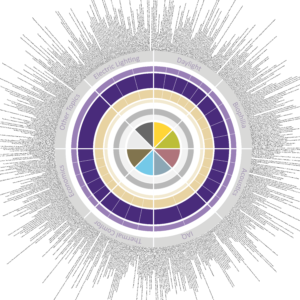About
The Rosetta Stone Translational Tool for Research-informed Practice is a joint collaboration between the University of Washington’s Integrated Design Lab and design industry partners. The tool developed out of a collective desire to clearly communicate the synergies of high performance design, in a way that is backed by research and evidence.
Its aim is to create a high-level translational literature review tool to help disseminate knowledge and information for a range of targeted audiences at varying level of depths of information and to equip firms with consistent, fit-for-purpose messaging and guidance to discuss different Value Cases of High Performance Design.
The Framework
 The tool is comprised of design elements and value cases that describe attributes of building design that impact the human health and perceptions of the built environment. These themes are driven by from empirical evidence. Example architectural design elements include Daylight, Acoustics, Biophilia, Indoor Air Quality, and Thermal Comfort with value cases such as Physical health, Mental Health, Performance, and Satisfaction. Each design element may have a subset of these value cases, and each value case may not be found within each design element.
The tool is comprised of design elements and value cases that describe attributes of building design that impact the human health and perceptions of the built environment. These themes are driven by from empirical evidence. Example architectural design elements include Daylight, Acoustics, Biophilia, Indoor Air Quality, and Thermal Comfort with value cases such as Physical health, Mental Health, Performance, and Satisfaction. Each design element may have a subset of these value cases, and each value case may not be found within each design element.
Several outcome goals have emerged for this project. First, our design industry partners see value in having citable information that supports high performance design at their fingertips. This tool was conceived as a mechanism to support conversations and decision-making with clients and building owners, and has also developed as a beneficial internal education tool that firms can use at various stages of projects or employee on-boarding. The design industry partners also saw value in collectively utilizing the same information so as to have a common language for disseminating information and helping build a foundation for the architecture profession as a whole. Some have interest in seeing and reading the primary literature themselves, and see value in having a connection to the most relevant literature for a given topic. Others wanted to see the briefest summary of the literature, distilled to its essence. The project aims to collect the research that exists about various topics, and simultaneously show where there is less research, or no information at all, so as to help draw attention to those areas, and even attract more research to be developed in those topic areas.
Hierarchy of Information
Based on the interests of various stakeholders the tool was created with a hierarchy of information, from very high-level, to very in-depth. These levels of information helped establish a framework that speaks to the organization of the tool, as well as the various audiences that may utilize the content.
 This wedge diagram provides a structure for the content that has been developed, highlighting the elements and relationships of the pieces of information that comprise the Rosetta Stone Translational Tool.
This wedge diagram provides a structure for the content that has been developed, highlighting the elements and relationships of the pieces of information that comprise the Rosetta Stone Translational Tool.
The Research Briefs are at the heart of the translation between academic research and valuable take-aways for architects and their clients. They outline research knowledge within each area and point toward the most current and relevant research articles as well as popular press articles that address the specific subject. It is from the Research Brief that the user can either dive deeper into the material, accessing the Collection Database, where original academic article citations can be referenced, or level-up for a higher-level overview in the Talking Points where bulleted statements summarize the key findings of research within each Value Case. Introduction pieces help set the stage for some topics. These original content pieces reside in the framework between the original review and primary research articles, and high-level popular press articles.
Process
The process of developing the information in tool includes 1) collecting relevant articles, both academic and popular press, 2) parring down the research based on identified criteria, 3) distilling or “translating” the research into pieces intended for identified stakeholder audiences, and 4) communicating the information through a framework that describes the content and provides access to our stakeholder network.
Each piece that is developed by the UW IDL and its design industry partners are reviewed by subject matter experts and practicing architects in an effort to vet the information presented, and to hone it to the most relevant for key industry stakeholders.
